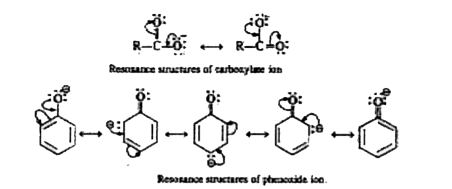Although phenoxide ion has more number of resonating structures than carboxylate ion, carboxylic acid is a strong acid than phenol. Why ?Solution in Punjabi
Both aliphatic carboxylic acids (RCOOH) and phenol have a tendency to release protons as follows :

Both carboxylic ion and phenoxide ion are resonance stabilised as explained below.

Although phenoxide ion has more number of resonating structures (five) than carboxylate ion (two) yet carboxylate ion is better resonance stabilised than phenoxide ion. It is due to the following two facts :
(i) The two contributing structure of carboxylate ion are structurally equivalent, whereas it is not so in case of phenoxide ion.
(ii) In carboxylate ion the negative charge in dispersed over two oxygen atoms, whereas in phenoxide ion, in four out of six resonance structures the negative charge is on less electronegative caron atom.
Due to bettwe resonance stabilisation of carboxylate ion the equilibrium is shifted more towards the right hand side in case of carboxylic acid than in phenol. Thus we can say that carboxylic acids have a greater tendency to release the proton or in other words carboxylic acid is more acidic than phenol.
Topper's Solved these Questions
- BOOK - BETTER CHOICE PUBLICATIONCHAPTER - ORGANIC COMPOUND WITH FUNCTIONAL GROUP CONTANING OXYGEN-IIEXERCISE - Question Bank (12.9 Uses of Carboxylic Acids)4videos
ORGANIC COMPOUND WITH FUNCTIONAL GROUP CONTANING OXYGEN-II
- BOOK - BETTER CHOICE PUBLICATIONCHAPTER - ORGANIC COMPOUND WITH FUNCTIONAL GROUP CONTANING OXYGEN-IIEXERCISE - Question Bank (12.7 Physical properties)4videos
ORGANIC COMPOUND WITH FUNCTIONAL GROUP CONTANING OXYGEN-II
- BOOK - BETTER CHOICE PUBLICATIONCHAPTER - HALOALKANES AND HALOARENESEXERCISE - QUESTIONS158videos
HALOALKANES AND HALOARENES
- BOOK - BETTER CHOICE PUBLICATIONCHAPTER - POLYMERSEXERCISE - QUESTIONS42videos
POLYMERS
Similar Questions
Sodium benzoate is used as a food additive. Why ?
04:31View SolutionCarboxylic acid exists as dimers, explain why ?
01:26View SolutionClassify the following organohalogen compounds as alkyl, allylic, benzylic, vinylic and aryl halides. Also state the type of hybridisation of the carbon of C-X band.

where X stands for halogen04:22View SolutionExplain the terms polymers and monomers ?
01:26View SolutionAlthough phenoxide ion has more number of resonating structures than benzote ion, benzoic acid is a stronger acid than phe4nol. Why ?
03:12View SolutionAlthough phenoxide ion has more number of resonating structures than carboxylate ion, carboxylic acid is a stronger than phenol. Why ?
04:01View SolutionAlthough phenoxide ion has more number of resonating structures than benzoate ion, benzoic acid is a stronger acid than phenol. Why?
03:13View Solutionयद्पि फिनॉक्साइड आयन की अनुनादी संरचानए कार्बोक्सिलेट आयन की तुलना में अधिक है परन्तु कार्बोक्स्लीक अम्ल फिनोल की अपेक्षा प्रबल अम्ल है । क्यों ?
View Solutionयद्यपि फीनॉक्साइड की पाँच अनुनादी संरचनाएँ होती हैं, किन्तु यह दो अनुनादी संरचनाओं वाले कारब्बोक्सिलेट आयन से कम स्थायी है, क्यों?
View Solutionकार्बोक्सिलेट आयन संगत कार्बोक्सिलिक अम्ल से अधिक स्थायी क्यों होता है?
03:37View Solutionयद्यपि कार्बोक्सिलेट आयन की तुलना में फिनॉक्साइड आयन अधिक संख्या में अनुनाद संरचनाएँ प्रदर्शित करता है तथापि ( कार्बोक्सिलिक अम्ल फिनॉल से अधिक प्रबल अम्ल होते हैं। क्यों?
03:14View Solutionयघपि फिनॉक्साइड आयन की अनुनादी संरचनाएँ कार्बोक्सिलेट आयन की तुलना में अधिक है परन्तु कार्बोक्सिलिक अम्ल , फिनॉल की अपेक्षा प्रबल अम्ल है , क्यों
03:38View Solutionयघपि फिनॉक्साइड आयन की अनुनादी संरचनाएँ कार्बोक्सिलेट आयन की तुलना में अधिक है । परन्तु कार्बोक्सिलिक अम्ल फिनॉल की तुलना में प्रबल अम्ल है । क्यों ?
View Solutionयद्यपि फिनॉक्साइड आयन, बेन्जोएट आयन की अपेक्षा अधिक अनुनादी संरचनाएँ रखता है, परन्तु बेन्जोइक अम्ल, फीनॉल से प्रबल अम्ल है| क्यों ?
05:13View SolutionA : Phenol is less acidic than benzoic acid. R: Phenoxide has less number of resonating . structures than benzyl carboxylate ion.
04:48View SolutionAssertion (A) : Phenol is less acidic than benzoic acid.
Reason (R) : Phenoxide has less number of resonating structures that benzyl carboxylate ion .02:15View Solution

